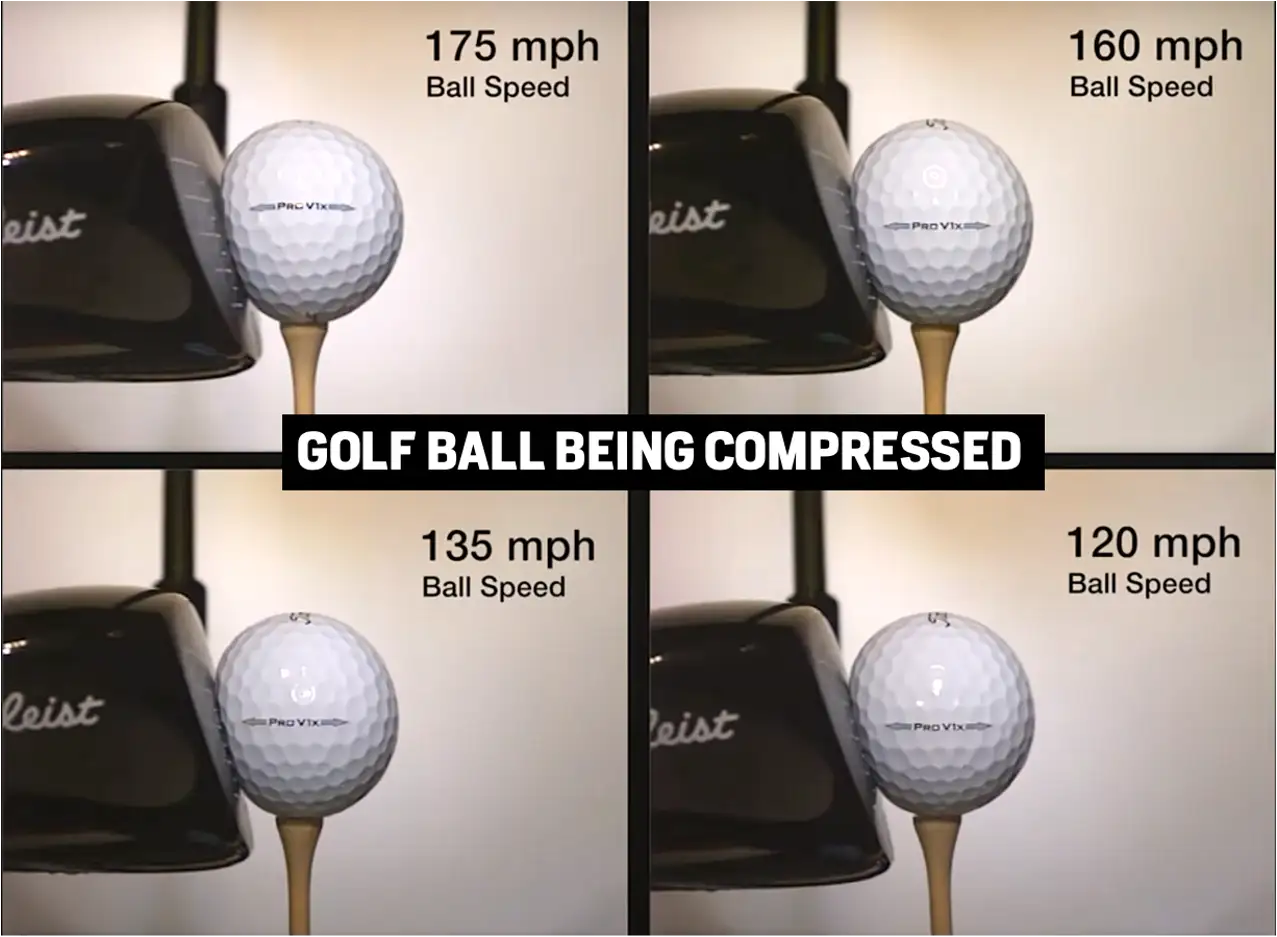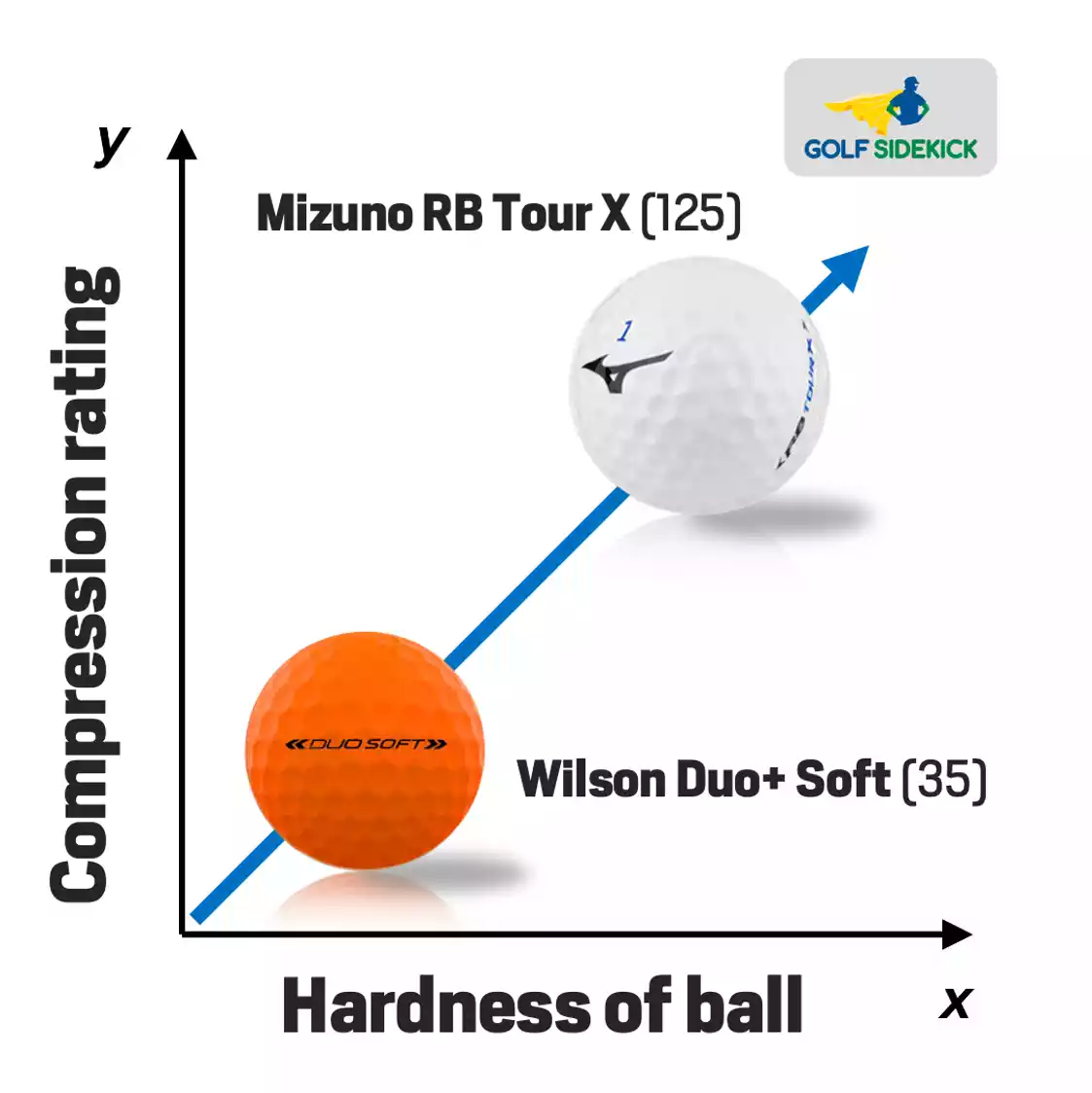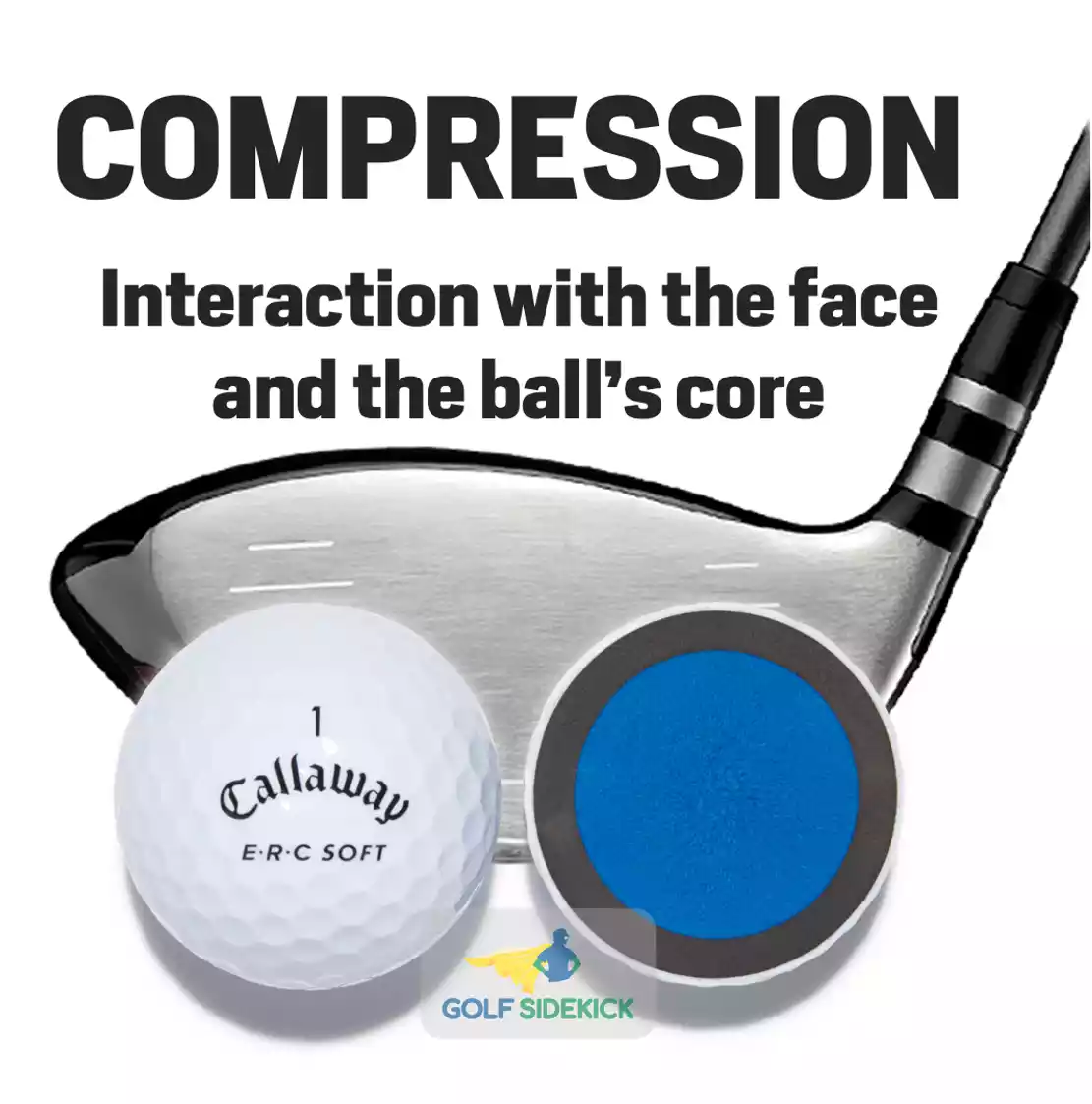Last Updated on January 31, 2024 by Matt Greene
If you can match the golf ball compression to your swing, you can gain distance and increase or decrease spin, depending on your goal.
A golf ball's compression rating is a rating of the softness or hardness of the ball.
Generally, the lower the compression rating, the easier the ball compresses.
Knowing which golf ball compression matches your swing speed, tempo and club head speed will get you closer to your goal. Understanding the compression of modern golf balls is the first step in the process of finding that perfect ball.

Golf ball compression explained
Golf ball compression is a rating or measurement of how much a golf ball deforms when it is hit. When a golf club hits a golf ball, the impact causes the ball to change shape as it compresses against the face of the club.
The ball will then spring off the face towards the target.
Compression stated on the golf ball or on a manufacturers' website are for the entire ball, but often manufacturers refer to core compression only.
Golf Ball Compression vs Swing Speed Chart
When we refer to swing speed, we are referring to the DRIVER swing speed specifically.
Driver swing speed is an easy benchmark because it is predictive of the swing you'll have throughout the bag.
There is one foolproof way to work out your driver swing speed so you can match it to the correct golf ball for you.
- Go to a Trackman or other radar-equipped driving range. You can hit many balls with your driver to establish your driver swing speed. This is the most accurate swing speed measurement equipment in golf.
With this information, you can now make an informed decision to select the correct golf ball compression from the ball compression chart and squeeze maximum performance from your golf ball. Keep in mind that you can increase your swing speed with the correct shaft.
There are cheaper options available within each swing speed bracket and I've included a price guide below.
Golf Ball Compression Charts | ||||
| Golf Ball | Layers | Golf Ball Compression | Swing Speed | Price Bracket |
High Compression Golf Balls | ||||
| Mizuno RBX Tour X | 4 Piece | High 110 | + 105 mph | $$$$ |
| Cut DC | 4 Piece | High 105 | + 105 mph | $$$ |
| Taylormade TP5X Pix | 5 Piece | High 100 | + 105 mph | $$$$ |
| Titleist Pro V1 X | 4 Piece | High 100 | + 105 mph | $$$$ |
| Volvik S4 | 4 Piece | High 95 | + 95 mph | $$$ |
| Callaway Chrome Soft X | 4 Piece | High 90 | + 95 mph | $$$$ |
| Cut Blue | 4 Piece | High 90 | + 95 mph | $$ |
| Mizuno RB Tour | 4 Piece | High 90 | + 85 mph | $$$$ |
| Vice Pro Plus | 4 Piece | High | + 85 mph | $$$ |
| Volvik Crystal | 3 Piece | High | + 85 mph | $$$ |
| Srixon Z-Star XV | 4 Piece | High 100 | + 105 mph | $$$ |
| Taylormade TP5X | 5 Piece | High 90 | + 95 mph | $$$$ |
| Wilson Staff Tour | 4 Piece | High | + 95 mph | $$$$ |
Medium Compression Golf Balls | ||||
| Callaway Warbird | 2 Piece | High 90 | + 95 mph | $ |
| Snell MTB-X | 3 Piece | High 90 | + 95 mph | $$$ |
| Srixon Z Star | 3 Piece | High 90 | + 95 mph | $$$ |
| Titleist Pro V1 | 3 Piece | High 90 | + 95 mph | $$$$ |
| Volvik XT AMT | 3 Piece | High 90 | + 95 mph | $$$$ |
| Bridgestone Tour B X | 3 Piece | Medium 85 | + 85 mph | $$$$ |
| Bridgestone Tour B XS | 3 Piece | Medium 85 | + 85 mph | $$$$ |
| Taylormade TP5 Pix | 5 Piece | Medium 85 | + 85 mph | $$$$ |
| Volvik S3 | 3 Piece | Medium 85 | + 85 mph | $$$ |
| Cut Grey | 3 Piece | Medium 80 | + 85 mph | $$ |
| Snell MTB – Black | 3 Piece | Medium 80 | + 85 mph | $$$ |
| Taylormade TP5 | 5 Piece | Medium 80 | + 85 mph | $$$$ |
| Titleist AVX | 3 Piece | Medium 80 | + 85 mph | $$$$ |
| Titleist Tour Speed | 3 Piece | Medium 80 | + 85 mph | $$$ |
| Volvik Vivid | 3 Piece | Medium 80 | + 85 mph | $$$ |
| Bridgestone e12 Speed | 3 Piece | Medium 75 | + 80 mph | $$ |
| Callaway Chrome Soft | 3 Piece | Medium 75 | + 80 mph | $$$$ |
| Srixon Q Star | 2 Piece | Medium 75 | + 80 mph | $$$ |
| Volvik Vi Max Soft | 2 Piece | Medium 75 | + 80 mph | $$ |
| Srixon Q-Star Tour | 3 Piece | Medium 70 | + 80 mph | $$$ |
| Taylormade Tour Response | 3 Piece | Medium 70 | + 80 mph | $$$ |
| Taylormade Project (a) | 3 Piece | Medium 70 | + 80 mph | $$$ |
| Volvik Power Soft | 2 Piece | Medium 70 | + 80 mph | $$ |
| Volvik XT Soft | 3 Piece | Medium 70 | + 80 mph | $$$$ |
| Callaway Strata Eagle | 3 Piece | Medium | + 80 mph | $ |
| Titleist Velocity | 2 Piece | Medium | + 80 mph | $$ |
| Volvik Solice | 3 Piece | Medium | + 80 mph | $$$ |
| Wilson ULTRA Distance | 2 Piece | Medium | + 80 mph | $$ |
| Wilson Tour Velocity Feel | 2 Piece | Medium | + 80 mph | $$ |
Low Compression Golf Balls | ||||
| Bridgestone Tour B RX | 3 Piece | Low (65) | < 80 mph | $$$$ |
| Bridgestone Tour B RXS | 3 Piece | Low (65) | < 80 mph | $$$$ |
| Cut Matte | 3 Piece | Low (65) | < 80 mph | $$ |
| Titleist Tour Soft | 2 Piece | Low (65) | < 80 mph | $$$ |
| Callaway ERC Soft | 2 Piece | Low (60) | < 80 mph | $$$ |
| Cut Red | 2 Piece | Low (60) | < 80 mph | $$$ |
| Srixon Soft Feel | 2 Piece | Low (60) | < 80 mph | $$ |
| Wilson Duo Professional | 3 Piece | Low (60) | < 80 mph | $$ |
| Bridgestone e12 Soft | 3 Piece | Low (50) | < 70 mph | $$$ |
| Wilson Fifty Elite | 2 Piece | Low (50) | < 70 mph | $$ |
| Callaway Superhot | 3 Piece | Low (50) | < 70 mph | $$ |
| Bridgestone e6 | 2 Piece | Low (45) | < 70 mph | $$ |
| Callaway Supersoft | 2 Piece | Low (40) | < 70 mph | $$ |
| Callaway Supersoft Magna | 2 Piece | Low (40) | < 70 mph | $$ |
| Taylormade Noodle Long / Soft | 2 Piece | Low (35) | < 70 mph | $$ |
| Wilson Duo Soft+ | 2 Piece | Low (35) | < 70 mph | $$ |
| Wilson Duo Optix | 2 Piece | Low (30) | < 70 mph | $$ |
| Mizuno RB 566 | 2 Piece | Low | < 80 mph | $ |
| Mizuno RB 566 V | 3 Piece | Low | < 80 mph | $ |
| Snell Get Sum | 2 Piece | Low | < 80 mph | $ |
| Taylormade Soft Response | 3 Piece | Low | < 80 mph | $$ |
| Titleist TruFeel | 2 Piece | Low | < 80 mph | $$$ |
| Vice Pro | 3 Piece | Low | < 80 mph | $$$ |
| Vice Tour | 3 Piece | Low | < 80 mph | $$ |
| Vice Pro Soft | 3 Piece | Low | < 80 mph | $$$ |
| Vice Drive | 2 Piece | Low | < 80 mph | $ |
| Wilson Zip | 2 Piece | Low | < 80 mph | $$ |
Kirkland Golf Ball Compression
Kirkland Signature golf balls have a compression rating of 94 which places them in the high compression category. As a 3 piece urethane covered golf ball, the Kirkland Signature characteristics are the same as a Srixon Z Star or a Titleist Pro V1.
What does a golf ball compression rating mean?
The golf ball compression ratings range between a score of 30 and 120. The softest being 30, and the hardest being 120.
Low compression golf balls are softer balls.
Higher compression golf balls are harder balls.
Do low compression or high compression go a further distance?
Compression and ball speed are related very closely.
- Generally, for FAST SWINGS OVER 105 MPH specifically, lower compression (softer) balls produce less ball speed and these fast swinging golfers lose distance with a low compression ball.
- "Soft balls are slow balls" is a confusing catch phrase thrown around the internet, so don't get confused.
- The biggest loss in distance using low compression golf balls is only for a higher swing speed (105 mph+) with the driver.
- For slower players (below 85 mph driver swing speed), the differences in ball speed and distance discrepancies between high and low compression balls are so small that we can disregard the notion that 'soft is slow' in this instance.
- For golfers who have swing speeds over 85 mph, producing more spin in excess of 2,750 rpm with the driver, lower spin produced by the low compression golf ball can actually make up for the distance you might lose with that same 'soft' low compression ball.
- In other words, the low compression ball reduces backspin enough to negate the 'slow' ball speed so that you actually benefit from the low compression ball.
As swing speed comes down, especially on iron shots, low-compression balls may be faster than firmer balls.
Soft balls make slow ball speeds but under the conditions above, the softer covers on high compression balls explain the differences in speed.
It's important to also remember that, soft balls do not spin.
The same design principles that make a ball soft also make a ball spin less.
The lowest spinning balls are low-compression balls throughout the bag; whether you look at the wedges, irons and even the driver.
If you need straighter shots with your driver or to remove spin in your irons, soft (low compression) balls work great. If however, you need more spin on approach shots, the soft low compression balls are not for you.
How does compression affect spin on the ball?
Low compression balls otherwise known as soft balls, are lower spinning than firm balls. The reason is the way they are constructed, not the compression.
Spin is the result of putting a soft layer (soft cover) around a hard layer (high compression core) and that is why low compression balls spin less. Their core is soft with a hard outer cover.
The covers on low compression balls are often hard ionomer while high compression balls that create high backspin, have a urethane cover.
It is possible to make a lower spinning hard ball but the soft balls spin the least in general.
How can low spin, low compression balls hold a green?
Most low compression golf balls have dimple patterns on the cover that create high trajectory shots.
The ball is made to create a higher ball flight and steeper landing angle to negate the loss of backspin and that is how the ball will stop closer to its pitchmark.
The soft inside core of softer balls means that soft or low compression balls usually produce lower spin.
Lower spin on a driver shot means a straighter ball flight, but a low spin iron shot can make it more difficult to stop the ball when you land on the green.
Any golf ball with a urethane cover (MULTI PLAYER TOUR BALL) will create more spin than a non-urethane cover (low compression 2 layer ball). By wrapping a high compression golf ball in a soft urethane cover, spin is created.
Does compression affect spin around the greens?
The main way that spin is produced on your short shots is from putting a soft layer around the hard layer - in other words, a urethane cover around the firm core of the ball.
Urethane golf balls will spin much more than ionomer/surlyn golf balls. This is universal and does not depend on a compression. If you want the most spin, you need golfball with 3 layers or more, and a urethane cover.
Callaway Super Soft, Srixon Soft Feel, and Wilson DUO will spin less around the green than a Tour ball like the Titleist Pro V1, Callaway Chrome Soft or Srixon Z-Star. The Tour ball has a urethane cover which is the softest layer of the ball, but underneath that, is a very firm layer. Onlymultiple layer balls with urethane covers spin significantly around the green.
The balls with the biggest difference in urethane softness and the underlying layer firmness will spin the most.
Which ball goes with which driver swing speed?
Faster swing speeds (above 100 mph)
Faster swings need higher compression golf balls. A higher compression golf ball will perform the way a fast swing needs the ball to perform while a low compression ball will lose distance in this swing speed range.
The options in this bracket will usually be a premium golf balls because high swing speeds are in the minority. A cheaper option in this category are the Kirkland Signatures.
Average swing speeds (85 – 100 mph)
If you are medium swing speed golfer, you have a choice when it comes to the ball you play.
Try out many golf balls depending on your driver spin rate and iron spin rate.
If you are a high spinning golfer, you may need a low compression ball to remove some of that spin. If you're a low spinning golfer, you do not need to lower spin even more, and you should go with feel. What feels best to you?
If you actually need more spin, choose a medium to high compression ball with a urethane cover.
Slower swing speeds (below 85 mph)
Distance is at a premium for slower swinging golfers so well-priced low compression golf balls are the best option. The softer the ball the more pleasant the sound, the lower the spin rate and the longer you'll hit the ball.
Do number of layers make a difference?
Players of different abilities will get more from balls with a specific number of layers.
If you're a high handicapper with a slower swing speed, a premium 5 piece golf ball isn't going to be suitable for you.
Here's a quick break down of how to choose the right number of layers for you:
2-Piece Golf Balls: The perfect golf ball for all casual golfers especially those with slower swing speeds. These balls are often well-priced. A great example of a two piece ball is the Srixon Soft Feel.
3-Piece Golf Balls: The Titleist Pro V1 is the gold standard of 3 piece golf balls and can be used by golfers with a variety of swing speeds and skill levels but I would reserve these balls for you when you lose fewer than 2 balls per round. Another good 3 piece ball is the Srixon Z star.
4 And 5-Piece Golf Balls: Super premium balls specifically designed for experienced golfers to optimize distance and control. These balls perform best for skilled players.
How do high and low compression balls feel?
- High compression balls will feel firmer. The sound off the club face is very clicky.
- Lower compression balls feel softer on the club face and make a sound that is more pleasing.
- The compression is not the only factor in the feel of a golf ball.
- The cover makes a bigger difference. Urethane covered golf balls feel much softer and are usually found on 3 piece golf balls.
- Ionomer or surlyn cover golf balls are found on the 2 piece golf balls and feel much firmer and clicker.
Final thoughts
If I have learned one thing about golf balls in my 25 years of playing golf and watching other golfers, it's that more expensive doesn't always mean better.
Everyone who starts the game thinks they should be playing a Titleist Pro V1, Callway Chrome Soft or TaylorMade TP5, but it's just not the case. These balls can cost upward of $4 each and will they make that much difference to the game of most golfers? No.
I play the Volvik S4 as it matches my swing speed (115 mph) and my needs around the green (stop quickly). This high compression golf ball wouldn't suit many of my playing partners and they would get better performance from a cheaper two piece ball.
As with nearly everything in golf, play around with options then stick to what works.
If you have some experience playing golf now, try not to bounce around different balls. Find one which works and learn how it reacts to your game. Learn the ball and learn with the ball. It'll save you strokes, I promise.


